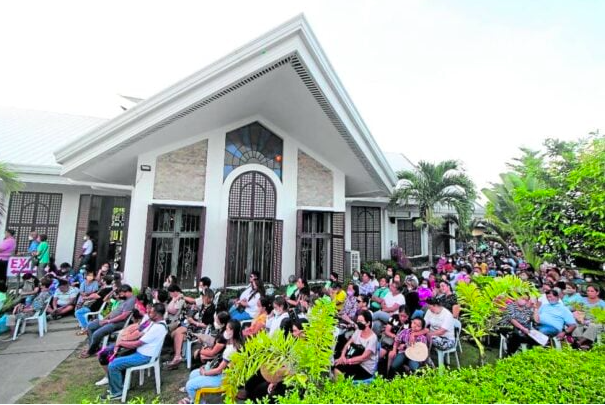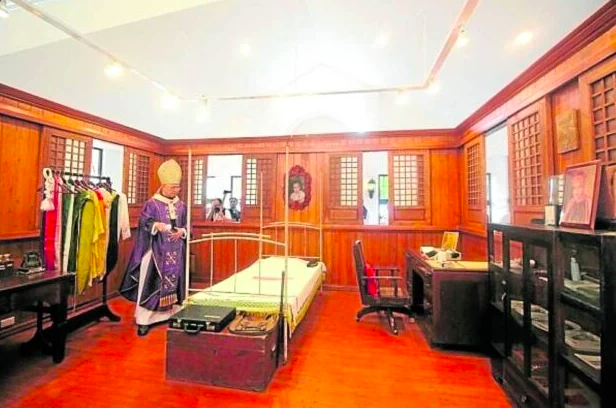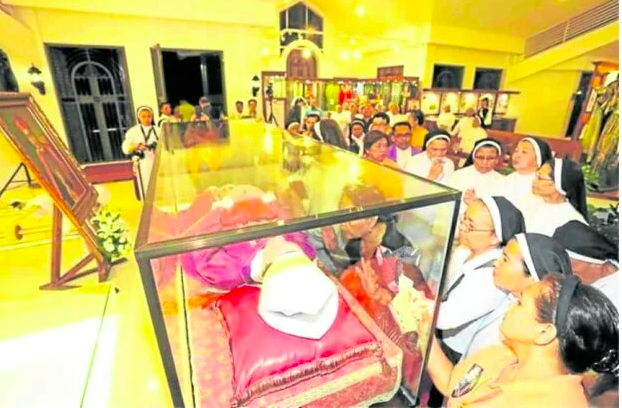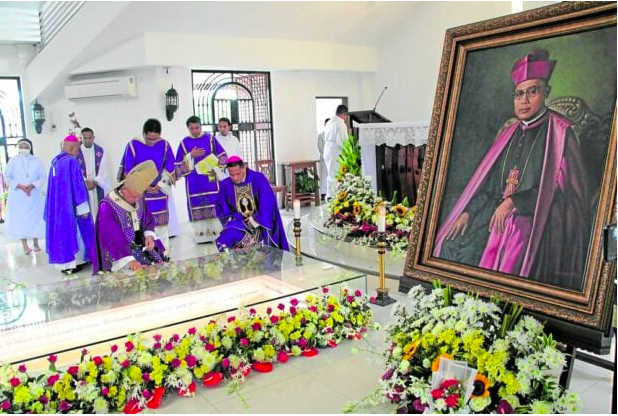Pilgrims find hope in tomb of Cebu bishop

LIFE IN SERVICE OF THE CHURCH | Pilgrims and tourists wait for their turn to visit “Domus Teofilo” in Carcar City, Cebu, where the remains of Archbishop Teofilo Camomot are interred. A museum featuring the prelate’s belongings and other materials and documents on his service to the Church and his flock gives visitors a glimpse of his life. (Photo by SAMMY NAVAJA)
CEBU CITY, Cebu, Philippines — Ace was 8 when he was diagnosed with a rare ailment.
In 2017, he was rushed to a hospital in Cebu City due to high fever and body weakness, which doctors attributed to Kawasaki disease.
Instead of wallowing in sadness, his grandmother and aunt traveled to Carcar City, about 40 kilometers south of Cebu City. They thought of seeking the intercession of the late Archbishop Teofilo Camomot, a candidate for sainthood since only a miracle could cure Ace of this acute febrile disease that affects children and causes the walls of the blood vessels in the body to become inflamed.
Kawasaki disease is a leading cause of heart complications, including aneurysm and coronary artery dilation.
“If you have faith, you’ll get what you want,” Ace’s aunt told the Inquirer.
They went to the tomb of Camomot and wiped a handkerchief on the grave of the late Cebuano prelate.
After saying a prayer, they returned to the hospital and rubbed it on the boy.
“Believe it or not, after five minutes, Ace’s fever was gone and he asked for food,” said the aunt, who asked not to be identified in this story.
Two days later, the boy was discharged from the hospital. Now 12, Ace is healed, with no traces of the ailment.
“We really believed that it was through Archbishop Camomot’s prayers to God that my nephew was healed. I believe that [Camomot] is now a saint. I hope he will be officially declared by the Church so that more people would seek his intercession,” she said.

MUSEUM DISPLAY Cebu Archbishop Jose Palma blesses the bed and other belongings of the late Archbishop Teofilo Camomot at a museum in “Domus Teofilo.” —CONTRIBUTED PHOTO
Museum
The tomb of Camomot has become a favorite pilgrimage site as people from all walks of life drop by to pray and venerate the remains of the well-loved prelate.
Between 500 and 1,000 people visit the “Domus Teofilo” (House of Teofilo) on weekdays and from 1,000 to 2,000 on weekends.
It is located on a 700-square-meter property owned by the Daughters of Saint Teresa (DST), the congregation founded by Camomot in 1959, at Barangay Valladolid in Carcar City.
Aside from the tomb, it also houses a museum that contains a bed and other personal belongings of Camomot. Also on display in the museum were books, vestments, typewriters and write-ups of the late Cebuano archbishop.
According to Fr. Mhar Vincent Balili, vice postulator for Camomot’s cause for sainthood, the bishop’s body was originally interred in the family’s mausoleum at Carcar Catholic Cemetery. The remains were eventually transferred to the DST compound in 2009 as part of the canonization process and to build a larger place for pilgrims.
Domus Teofilo was opened to the public on March 3, 2017.
Since then, the number of pilgrims has tripled—among them children, the elderly, the sick and “balikbayan.”
“Many of them [pilgrims]prayed for physical, emotional, financial and spiritual healing. There were those who pray to pass the board exams, and sick people with incurable illnesses,” Balili said.
Entry to Domus Teofilo is free but the DST accepts donations since the congregation has a foundation to fund the canonization process of Camomot.
The museum was designed by architect Arnold Saballa and constructed under the supervision of Fr. Brian Brigoli, chair of the Cebu Archdiocesan Commission on Culture and Heritage.
The skull and bones of Camomot are placed inside a wax statue of the prelate, which is displayed for public viewing at Domus Teofilo from 8 a.m. to 6 p.m. daily.

HOLY PLACE | Nuns, priests and laypeople venerate a wax sculpture containing the skeletal remains of Archbishop Teofilo Camomot before its entombment in “Domus Teofilo” (House of Teofilo) in Carcar City on Jan. 4, 2018. (CONTRIBUTED PHOTO)
Driven by faith
Balili urges those visiting Domus Teofilo to widen and deepen their intentions.
“Don’t just go there out of curiosity or as a tourist. What led us there should be faith and the determination to emulate the life of Archbishop Camomot,” he said.
Balili said the museum was purposely designed to educate people about the life and virtues of Camomot.
“In that way, people will know who Archbishop Camomot was. And from there, they pray and seek his intercession,” he said.In 2010, the Vatican approved the opening of the cause for Camomot’s sainthood.
Seven years later, the Vatican’s Congregation for the Causes of Saints approved the diocesan process that included the gathering of documents and writings of Camomot as well as the testimonies of witnesses who had personal encounters with the archbishop.
A “Positio,” which summarizes the life and virtues of Camomot, was submitted to the Vatican in 2020. The following year, a special group composed of nine theological consultants gave their unanimous approval on the “heroic virtues” of the prelate or the performance of extraordinary virtuous actions over a period of time.
On May 21, 2022, Pope Francis allowed the granting of the title of “venerable” to Camomot, the first of three steps to sainthood.
A miracle is needed for Camomot to become “blessed” and another miracle to become a saint. Balili and the DST nuns are in the process of gathering testimonies of people who experienced miracles by seeking Camomot’s intercession.

Cebu Archbishop Jose Palma (wearing a miter) and members of the clergy offer prayers at the tomb of the well-loved Cebuano prelate (in portrait) who is a candidate for sainthood. (Photo by SAMMY NAVAJA)
‘Ordinary, inconvenient life’
Camomot was born in Barangay Cogon, Carcar City, on March 3, 1914. The third of eight children first thought of taking up secondary education at an agricultural school but decided to enroll at the diocesan seminary in Cebu City on the advice of his older brother, Diosdado, also a priest.
After his ordination in 1940, Camomot started to carve a name for himself: He was known for his simplicity as well as for his generosity to his parishioners.
He visited the sick and gave them food and medicines. He also helped those who sought his assistance. He was quick to share whatever he had and didn’t mind giving away all he had, including his episcopal ring and pectoral cross (the crucifix worn by bishops).
True to his name “Teofilo,” which means “lover of God,” he taught children how to pray, and convinced people to be close to God.
It was during his deployment in Misamis Oriental in 1959 as coadjutor archbishop of Cagayan de Oro when he founded the Carmelite Tertiaries of the Blessed Eucharist, now the DST.His last assignment was in Carcar, his hometown, where he was named parish priest in 1976.
He died in a vehicular accident in San Fernando town on Sept. 27, 1988, while on his way back to Carcar after attending a gathering of priests in Cebu City. He was 74.
According to Balili, Camomot’s life was “nothing close to spectacular.”
“He lived an ordinary and inconvenient life, but he lived it extraordinary well while embracing the sufferings that befell him. He simply went the extra mile. For him, preaching is not enough. The Word has to become flesh,” he said.
But Balili said the archbishop’s legacy continues to resonate across the regions.
“Archbishop Camomot undoubtedly left an indelible imprint on the hearts of people. His life never stops. It has only begun to multiply through the people who long to perpetuate his memory by following in his footsteps,” he said.
RELATED STORIES
Thanksgiving Mass held in Cebu for ‘venerable’ late archbishop Teofilo Camomot
Pope Francis declares late Cebuano archbishop Camomot ‘venerable’
Remains of Archbishop Camomot, candidate for sainthood, exhumed
Disclaimer: The comments uploaded on this site do not necessarily represent or reflect the views of management and owner of Cebudailynews. We reserve the right to exclude comments that we deem to be inconsistent with our editorial standards.
